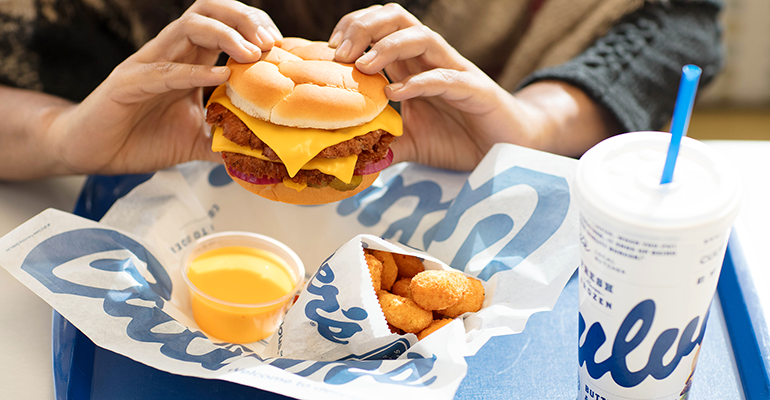What makes people really love a restaurant brand? Not just “what brand do they most frequent?” because inevitably the McDonald’s and Starbucks of the world would be at the top of the list purely as the winners of a numbers game. Rather, what makes people put that restaurant at the top of their mental list of favorite places to eat?
Technomic’s 2023 data for America’s Favorite Chains offers a detailed, and sometimes surprising, glimpse into the psyche and stomachs of the American consumer. Both high and low price points dominated the list: brands that reflect budget-conscious consumption trends, as well as chains that offer pricier in-person experiences that consumers could not easily get anywhere else. In fact, America’s top 10 favorite chains list is dominated by smoothies (Tropical Smoothie Cafe and Smoothie King) and steak (Ruth’s Chris Steak House, LongHorn Steakhouse, Fleming’s Prime Steakhouse and Wine Bar, and The Capital Grille).
Want to dig deeper into America’s Favorite Chains? Follow the below links.
- Gen Z’s favorite restaurants
- Millennials’ favorite restaurants
- America’s favorite restaurants for burgers, chicken, pizza, and more
- How restaurants Ruth’s Chris and Dutch Bros became America’s Favorite Chains
- America’s 10 favorite restaurant chains
Other notable trends within different categories include the tough-to-define “cool factor,” the perception of health, the winning “Goldilocks effect” of the mid-sized chain, the love for breakfast and sandwiches, and the particularly post-pandemic draw of a unique experience.
“If you think about how economic drivers have affected customers, these convenience-leaning concepts are winning out since spending has been a little tighter,” said Michael Parlapiano, managing director of restaurant consulting firm The Culinary Edge. “On the other hand, steak and full-service winners like Seasons 52 and First Watch are all meeting a different consumer need. … The convenience brands are providing experiences that customers look for in specific need states, while brands that really excel in hospitality are … providing an experience that can't be replicated at home and an itch that can’t be scratched by convenience.”
 The ubiquity of steakhouses in the list of America’s Favorite Chains is perhaps the easiest to explain: Steakhouses are associated with special occasions and celebrations. So, while they might not be as highly frequented as quick-service chains, they occupy a larger mental space in the minds of consumers and are associated with memories of happy occasions. Also, steakhouses and similar high-end dining experiences correspond with more personalized service at the top of the full-service dining scale.
The ubiquity of steakhouses in the list of America’s Favorite Chains is perhaps the easiest to explain: Steakhouses are associated with special occasions and celebrations. So, while they might not be as highly frequented as quick-service chains, they occupy a larger mental space in the minds of consumers and are associated with memories of happy occasions. Also, steakhouses and similar high-end dining experiences correspond with more personalized service at the top of the full-service dining scale.
“A consumer having an excellent experience at a restaurant is nearly always determined by the occasion,” said Robert Byrne, director of consumer and industry insights for Technomic. “You could go to a place with bad food but have the best time because you were with your best friends, and the staff was vibing with you, but someone else might have a totally different experience. … At a steakhouse, you’re opening your wallet wider, so your sliding scale of value changes because you’re going for a steak for a special occasion. And steakhouses never fail to deliver on service.”
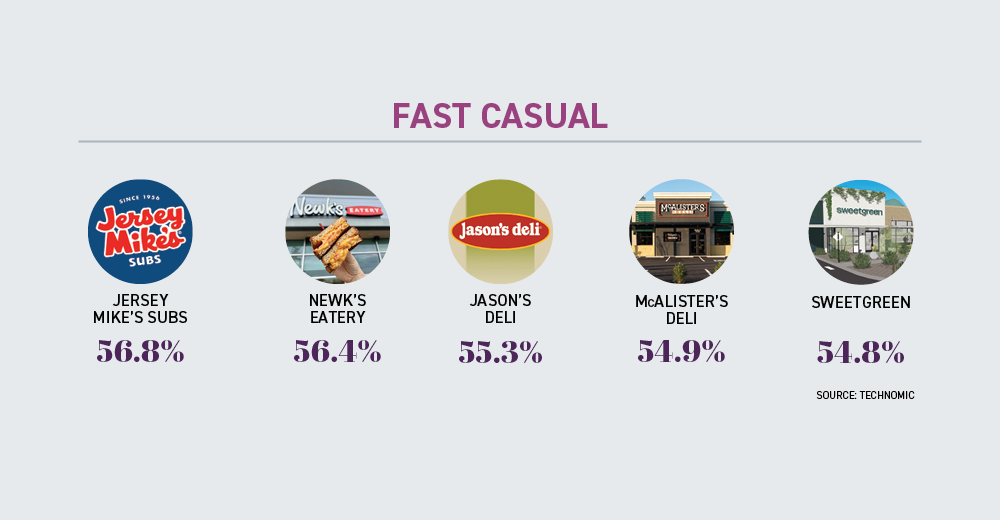 The lower-end brands that have popped up in the America’s Favorite Chains data are not as easily explained as the steakhouses. The popularity of smoothies is clear: Tropical Smoothie Cafe is one of the most mentioned brands in this data set (appearing a whopping five times in different categories) and Smoothie King was named the No. 1 limited-service brand among millennials. The reason for that might be wrapped up in convenience, perception of health, and consistency — it’s harder to mess up a smoothie.
The lower-end brands that have popped up in the America’s Favorite Chains data are not as easily explained as the steakhouses. The popularity of smoothies is clear: Tropical Smoothie Cafe is one of the most mentioned brands in this data set (appearing a whopping five times in different categories) and Smoothie King was named the No. 1 limited-service brand among millennials. The reason for that might be wrapped up in convenience, perception of health, and consistency — it’s harder to mess up a smoothie.
However, brands in more commonly considered categories in the quick-service lane — like burgers, chicken, pizza, and tacos — don’t appear on this list nearly as often. Beverages and snacks (including Dutch Bros for coffee and Cold Stone Creamery for ice cream) reign supreme here.
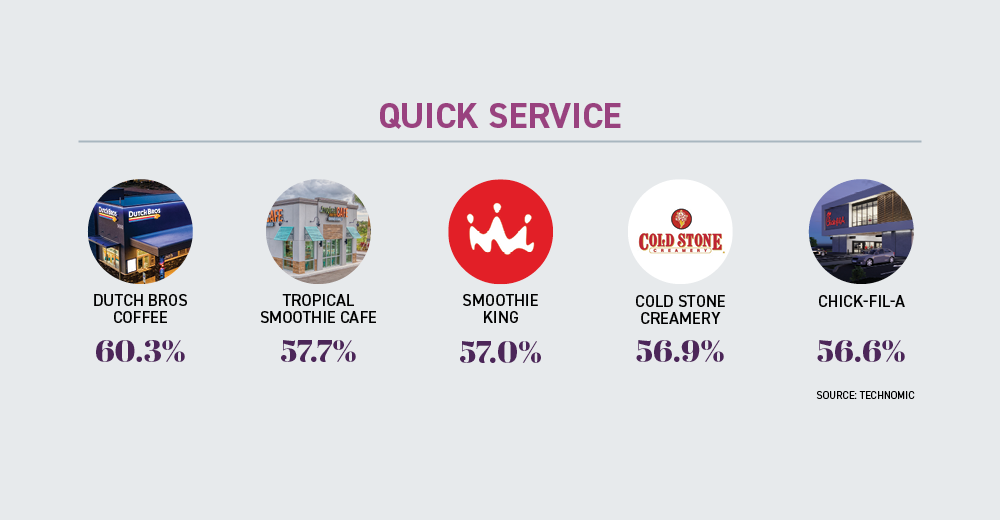 “Smoothies are cold, sweet, and fruity; those three things are always going to win the hearts of young consumers,” Byrne said. “So, it's all these things, it's in a cup, it’s functional, it has the flavor profiles that you want, and also tends to come at a price point that is a lot more palatable than your $16 Big Mac meal.”
“Smoothies are cold, sweet, and fruity; those three things are always going to win the hearts of young consumers,” Byrne said. “So, it's all these things, it's in a cup, it’s functional, it has the flavor profiles that you want, and also tends to come at a price point that is a lot more palatable than your $16 Big Mac meal.”
Smoothies, ice cream, coffee, and other similar restaurant categories reflect another emerging trend: the lure of the specialized menu. Whereas many of the classic limited-service brands are jacks of all trades and offer everything from burgers, chicken and breakfast to fries, salad, and coffee, several of the brands mentioned in this data set have smaller, more specialized menus. According to Parlapiano, having a “clear and focused offering” allows brands to get really good at doing one or two particular things well, rather than stretching themselves too thin.
Specialized menu execution is not just limited to limited-service restaurants, either; full-service breakfast restaurant First Watch was No. 1 in the midscale and family-style categories and ranked in the top 10 for both Gen Z and millennials. In fact, breakfast is one of the fastest-growing specialized menu categories in America. For First Watch, being recognized multiple times in America’s Favorite Chains is a validation of the brand’s approach to innovation and consistency.
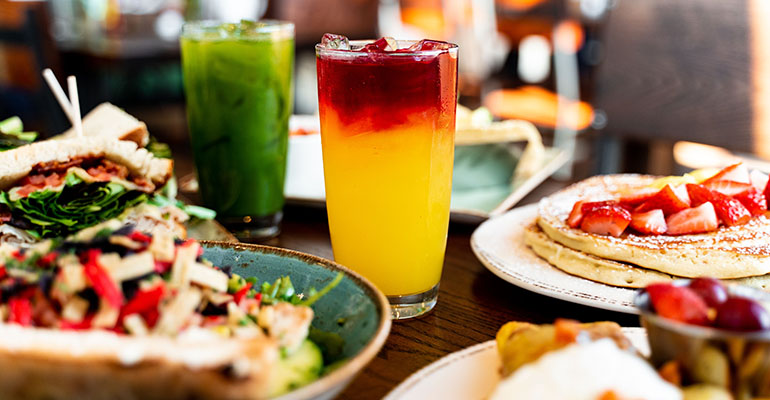
First Watch’s brunch menu has resonated with many younger consumers.
“We always talk about being the best-kept secret in the restaurant industry,” said First Watch chief brand officer Matt Eisenacher. “So, when we hear about making a list when not everyone is aware of us, it says a lot about us just keeping our heads down and trying to run a great restaurant brand. … In times of turmoil, consumers will gravitate toward a place they know they can trust, and they know what to expect. We are not perfect, but we are very consistent. You’ll experience lots of smiles and prompt service in our more than 500 restaurants, and I think that goes a long way.”
Eisenacher said that although First Watch does not intentionally go after a younger demographic, he thinks that the company’s progressive fresh take on both its menu and branding is appealing to Gen Z (who named First Watch their second-favorite full-service restaurant).
“The younger generation will say they don’t drink coffee, even though the drink in their hands might have coffee in it but doesn’t resemble traditional coffee because their trends and preferences are just so different,” Eisenacher said as an example. “They are one of the reasons we launched our line of iced coffees.”
The idea of First Watch as one of the best-kept secrets of the restaurant industry despite the chain’s 500-plus locations might sound like a joke, but the perception of exclusivity is also a crucial trend in Technomic’s data. Cooper’s Hawk is one of the few non-steakhouse, non-smoothie chains in the top 10 favorite chains. The concept is highly specialized (focusing on its Napa wine club), experiential, and also has the “cool factor” benefit of being a smaller regional favorite with only 52 locations.
“A brand must be able to consistently deliver outstanding service and unforgettable experiences to build trust and drive loyalty,” Cooper’s Hawk CEO Tim McEnery said. “We marry this belief with the joy that comes from celebration and connection. Community and culture are the foundation of everything we do, from the restaurants to the wine club to our team members.”
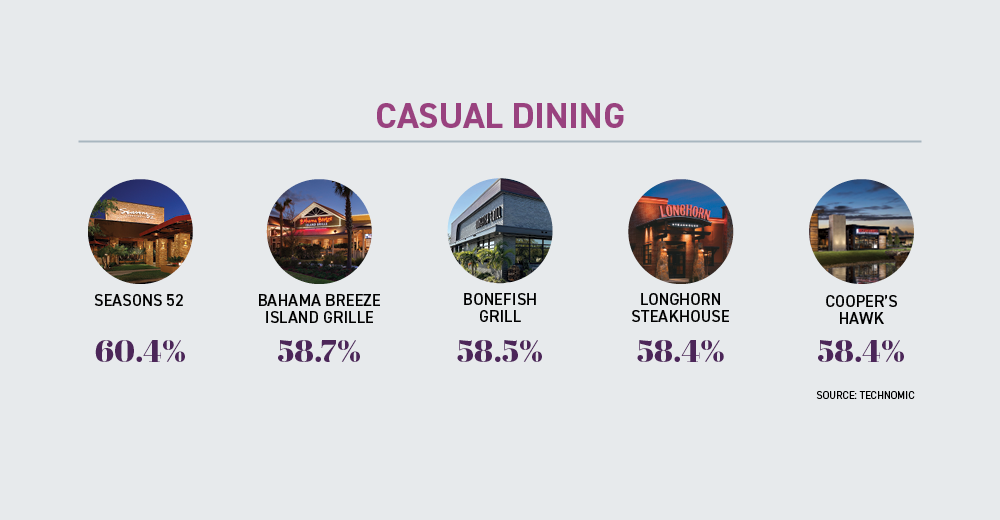 Although Cooper’s Hawk is featured in the top 10, the wine bar brand is in a minority of small restaurant chains (fewer than 100 restaurants) mentioned in America’s Favorite Chains. However, on the other end, the largest brands with more than 1,000 locations had the fewest spots on the list, and only two top 25 brands by unit count — Chick-fil-A and Jersey Mike’s — were mentioned at all.
Although Cooper’s Hawk is featured in the top 10, the wine bar brand is in a minority of small restaurant chains (fewer than 100 restaurants) mentioned in America’s Favorite Chains. However, on the other end, the largest brands with more than 1,000 locations had the fewest spots on the list, and only two top 25 brands by unit count — Chick-fil-A and Jersey Mike’s — were mentioned at all.
The “Goldilocks effect” of restaurant popularity appears to favor mid-sized chains. Most of America’s Favorite Chains have somewhere between 400 and 800 locations — large enough to be recognized and remembered by more people, but small enough to take on a “cool factor” role in people’s minds.
“When you get too big to control the quality and service, you become a victim of ubiquity, which has always been McDonald’s problem,” Byrne said. “I could go get some McDonald’s fries right now because they’re super reliable. Everyone has McDonald’s sometimes. But are they great? Are you going to go out of your way for them? The answer is no. They’re just convenient. When you get to be a certain size, you’re not as special anymore.”
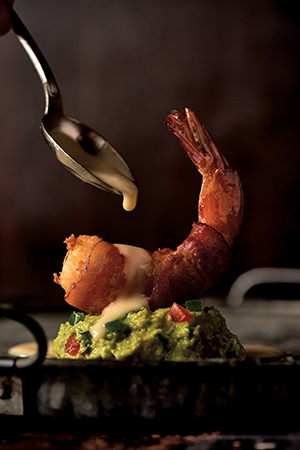 Photo: Cooper’s Hawk isn’t just about wine: pictured here is the brand’s Mexican drunken shrimp.
Photo: Cooper’s Hawk isn’t just about wine: pictured here is the brand’s Mexican drunken shrimp.
However, the cool factor doesn’t always correlate with portfolio size; sometimes it comes down to a restaurant’s cult-like status among loyal customers. Dutch Bros, Chick-fil-A, and In-N-Out are all in differing stages of growth, but all three brands inspire fierce defense and obsession from their fans. Chick-fil-A is the largest brand featured in the Technomic data at nearly 3,000 locations. In-N-Out, meanwhile, has the advantage of being a regional favorite, so people from California can feel proud of their local burger that (largely) can’t be found in the Eastern half of the U.S. Both brands are well-known for their dedication to speed of service.
“Nobody’s doing a better job at engineering the drive-thru than those two brands,” restaurant consultant Aaron Allen said. “That is what’s driving the sentiment. Plus, they’re less greasy. … There’s also some regional preference, but the service at the drive-thru is the other half. Life moves so fast so when you see a line at Chick-fil-A, you know it’ll move quick, while next door at Starbucks or McDonald’s, you could be waiting 15-20 minutes.”
The other consumer trend that the Technomic data picks up on is the aspirational attachment to healthier foods. Smoothies fall into this category, but sandwich concepts — which appear more often in the dataset than salad brands — do as well, likely for their appearance of freshness and a more healthful food occasion. Shockingly, besides Sweetgreen, zero bowls-focused brands made it onto the list of top fast-casual chains — including the king of burrito bowls, Chipotle Mexican Grill. Instead, Jersey Mike’s, Newk’s Eatery, Jason’s Deli, and McAlister’s Deli round out the most beloved fast-casual chains list.
“I think the world has moved toward bowls in recent years, but the sandwich will always remain king, at least in terms of broader demographic needs at lunch,” Parlapiano said. “It’s convenient and also more familiar. I think sandwiches are top of mind for consumers.”
Contact Joanna at [email protected]
Methodology
Data for America’s Favorite Chains comes from Technomic Ignite Consumer, which collects information about how brands impact consumers and how consumers interact with those brands, via online survey. Respondents are shown the list of chains tracked and asked which they are familiar with, then how often they visit those chains. They are then randomly assigned one chain at which they have ordered a foodservice item in the past 30 (LSRs) or 60 (FSRs) days. Consumers then evaluate that chain on a variety of attributes based on their most recent occasion, providing details about their visit such as daypart, party composition, etc. Finally, they are asked about how important various attributes are in their decision to visit different types of restaurants. Percentages represent a composite top-box rating, indicating the share of recent guests who gave the brand the highest possible rating for each of the guest experience attributes. Each year, Technomic Ignite Consumer polls 112,000 nationally representative consumers ages 18-plus. Surveys are continuously fielded and data is compiled quarterly. Learn more about Ignite Consumer at www.technomic.com/ignite-consumer.
ABOUT TECHNOMIC
Technomic Inc., an Informa company, was founded as a management consulting firm in 1966. Since then, Technomic’s services have grown to encompass cloud-based B2B research tools, consumer and menu trend tracking and other leading strategic research and analytic capabilities, to prioritize and size business opportunities. Our clients include food manufacturers and distributors, restaurants, retailers and multiple other business verticals aligned with the food industry that are looking to make informed decisions to support their business growth. Visit Technomic at www.technomic.com.

